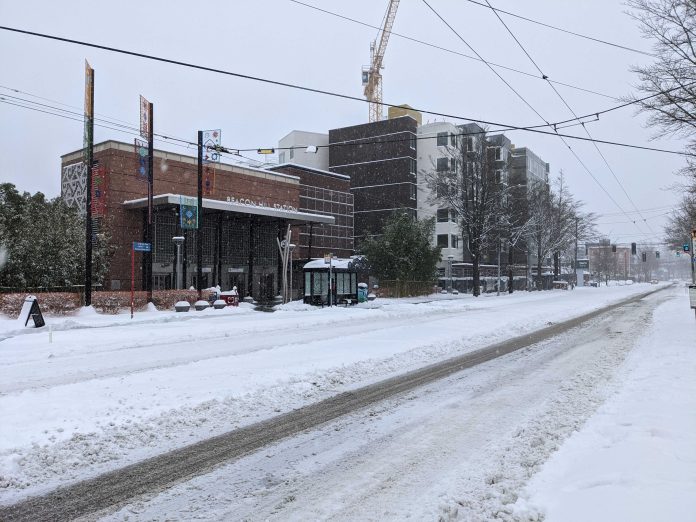Repeal Faircloth: The Faircloth Amendment is still on the books. What does that mean for public housing?
Parked out: Car ownership rates have peaked in Seattle, but only one other of the ten densest major cities in America has a higher rate of car ownership ($).
Helmet review begins: King County is taking another look at the bike helmet law, which could lead to repeal.
If cities were in charges: What would the next national infrastructure bill look like if cities were in charge?
Hotels for housing: Will King County shelters be able to keep using hotels for people experiencing homelessness? The future is unclear.
Closing stores: Kroger is closing two underperforming QFC grocery stores in Seattle.
Charting paths: The SkyTrain extension to University of British Columbia along Broadway is still uncharted, but regional discussions in Vancouver are ongoing.
Transit access as priority: Moving on from the pandemic, Bloomberg CityLab suggests that transit agencies should look beyond the ridership metric and instead to transit access.
Dystopian: A Nevada bill could allow tech companies to make their own local governments.
Shrunken street: The Green Lake Keep Moving Street is set to shrink this week.
LAX highway pricing: A decongestion pricing study is taking shape in Los Angeles.
New WTC tower: A new 900-foot mixed-use tower to replace the heavily damaged 5 World Trade Center in the 2001 terrorist attack has been approved.
Delayed again: Delivery of the 2020 census results is now further delayed until September. Numbers for reapportionment are also further delayed until late April.
Higher linkage fee: Boston’s mayor is proposing a 42% increase in the commercial linkage fee charge for affordable housing, raising the fee from $10.81 per square foot to $15.39.
Still a crisis: Publicola reports a board membership shakeup for the King County Regional Homelessness Authority and how legislative changes in Mercer Island on expelling people experiencing homelessness could violate court orders.
Revising policy: A new Biden administration policy will make it easier for large transit projects to qualify for grant funding.
Connecting the valley: Los Angeles is looking at several high capacity transit options to connect the San Fernando Valley to Santa Monica/Westside.
Lowered estimates: Estimates of a pied-à-terre tax in New York City appear to show that the city would get a much smaller take than originally thought.
ALOHA homes: A new bill in Hawaiʻi could deliver a significant number of affordable homes to Hawaiians.
HSR now: A new federal bill could deliver tens of billions of dollars for high-speed rail.
Simplified connections: Under a new federal rule, airports and cities can continue to charge a facilities facility and scrap the need for connecting people movers to transit lines instead allowing the fee to bring regular transit lines more directly to airports.
Repurposing office space: Boise may start to put affordable housing into vacant office buildings.
Mount Zion: A senior affordable housing project is taking shape on 19th Ave in Capitol Hill.
Station access: A trick to increase ridership and reduce commute times on transit systems is improving station access, making it easier to reach platforms.
Connecting communities: Georgetown residents are pushing to get a bike connection to downtown Seattle back onto the agenda.
Grab-and-go yourself: Food delivery apps are hurting already tough margins for local restaurants.
Wealthy tax handouts: Massachusetts’ electric vehicle rebate program is mostly just benefiting wealthy suburbanites.
Land bridge: A land bridge project in Minnesota is seeking to restore and reconnect a Black neighborhood.
Whole buffalo: Charles Marohn opines on the skinniest house in London in relation to the efficiencies of old cities and how modern development often does not seek that out.
Map of the Week: Greater Greater Washington maps out what the intersection configuration within the Beltway looks like, which really differentiates urban and suburban areas clearly.
Stephen is a professional urban planner in Puget Sound with a passion for sustainable, livable, and diverse cities. He is especially interested in how policies, regulations, and programs can promote positive outcomes for communities. With stints in great cities like Bellingham and Cork, Stephen currently lives in Seattle. He primarily covers land use and transportation issues and has been with The Urbanist since 2014.


